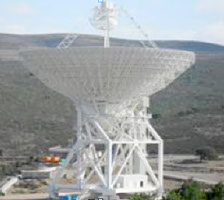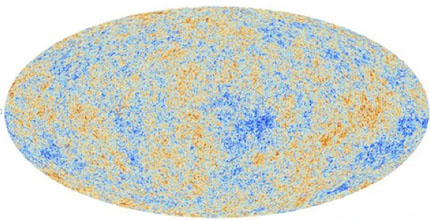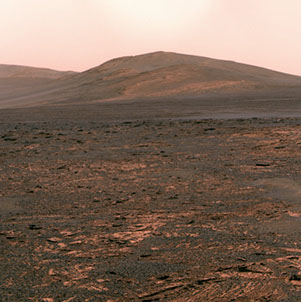



November 2013
Sardinia Radio Telescope
A new radio telescope is up and running. The Sardinia Radio Telescope was activated in Italy. The new scope is 64 meters in diameter and will study deep space objects such as pulsars, nebulae, quasars and black holes as well as search for signals of extraterrestrial origin.

Additionally, the scope will be able to be a radio link to deep space probes like Voyager 1. It can even be used in the field of geodynamics, linking with other radio telescopes to detect the displacement of "plates" in the lithosphere, which cause earthquakes.
The telescope will cover the frequencies from 0.3 to 100 GHz. The scope stands as high as a 20 story building and consists of one thousand aluminum panels. It has an accuracy of fractions of a millimeter. The scope is located about 35 kilometers from Cagliari.
Planck Telescope
The Plank space telescope has reached the end of its mission. The telescope had mapped the 'oldest light' in the universe. The telescope was placed far from earth, at about 1.6 million kilometers away to conduct its studies. But now the scope has been shut down and is drifting off into space.
Plank surveyed the Cosmic Microwave Background, the first light in the universe after the Big Bang when the universe cooled enough to form hydrogen atoms. Scientists say that before that time matter and radiation would have been so hot that the universe would have been opaque.
Data gathered from Plank will be studied for years and may unlock many mysteries of the Big Bang itself. The first moments of the universe may be imprinted in that Cosmic Microwave Background. We may be able to probe the universe less than a billionth of a second after it began.
Theory says that matter and light decoupled about 380,000 years after the Big Bang. Matter formed stars and galaxies while the light spread out and cooled forming the Cosmic Microwave Background.
Plank determined that the universe is made of 4.9% normal matter (the atoms from which we are made), 26.8% dark matter (the invisible material holding the galaxies together) and 68.3% dark energy (the mysterious component accelerating cosmic expansion). Plank also determined the rate of universe expansion which suggests that the universe is 13.8 billion years old.

Map of Cosmic Microwave Background
Visit our sponsors.
For advertising opportunities on this page and our videos, contact
Upcoming Launches
Date: November 6
Launch Vehicle: Soyuz 37
Launch Site: Baikonur Cosmodrome, Kazakhstan
Description: Soyuz 37 will carry three Expedition 38/39 crew members to the International Space Station
Date: November 18
Launch Vehicle: Atlas V
Launch Site: Cape Canaveral AFS, Florida, Launch Complex-41
Description: Mars Atmosphere and Volatile EvolutioN (MAVEN). To study the Martian atmosphere and determine the role that loss of the atmosphere to space played in changing the Martian climate.
Date: November 20
Launch Vehicle: ISS Progress 53
Launch Site: Baikonur Cosmodrome, Kazakhstan
Description: Progress 53 will carry supplies, hardware, fuel and water to the International Space Station.
Image Credit: ESA/Plank Collaboration
Lost Planet
It is a planet without a star. A lost planet drifting amongst the cosmos. The planet was picked up on data produced by the Pan-STARRS 1 wide-field survey telescope on Haleakala, Maui, Hawaii.
Scientists have been monitoring the planet for two years trying to determine if it is in fact a planet or a brown dwarf star. They were looking for brown dwarfs when they discovered this object, now known as PSO J318.5-22. Using data gathered over this period it was determined the object is in fact a planet. It is the first time a free-floating planet in space has been discovered.
PSO J318.5-22 is located only 80 light-years from earth and is about 12 million years old. It is similar to the gas giants in our solar system, like Jupiter.
Exo-planets
Over 1000 and counting. That is the number of planets orbiting other stars that have now been confirmed. Twelve of those planets are orbiting their stars at a distance that would make them just the right temperature for liquid water to form.
Most of these planets were spotted by the Kepler Space Telescope. But Kepler has broken down so now scientists are studying the data that Kepler had returned. There are still over 3500 more candidates to examine.
Using Kepler data, scientists estimate there could be over 17 billion Earth-sized exo-planets just in our own Milky Way galaxy. Most exo-planets discovered to date are large planets on the size of Jupiter. This is due to the fact that bigger planets are easier to detect. Instruments are getting more refined, but so far lack of funding has prevented new telescopes from being constructed. Astronomers note that when we eventually get new scopes the number of Earth-sized exo-planets detected will soar.
.....CLOUDS DETECTED ON EXO-PLANET.....
Using data from both the Kepler and Spitzer space telescopes, astronomers have been able to map clouds on an exo-planet. The planet is known as Kepler-7b and is a large gas giant similar to Jupiter. It is the first time scientists have been able to map the clouds on a planet orbiting another star.
Scientists have observed that the climate on this planet is pretty stable. It is a hot world where temperatures range from 1500 to 1800 degrees Fahrenheit. The Kepler scope originally detected a bright spot on the planet which the Spitzer scope was then able to analyze using the infrared spectrum to determine they were clouds. Astronomers are now able to not only find planets orbiting distant stars, but can now begin to understand them as well.
z8_GND_5296
Scientists have found a galaxy over 13 billion light years away. It is the most distant galaxy found to date and has been dubbed z8_GND_5296. Since it has taken the light that long to get here, we are actually seeing what the galaxy looked like that many years ago. The universe at the time was only 700 million years old.
Examining the galaxy, scientists have learned that it was producing stars at a rate of over 100 times faster than our Milky Way is producing stars today. By studying distant galaxies, it has been determined that star formation rates began to decrease about 10 billion years ago.
Martian Meteorite
A Martian meteorite has revealed clues as to how Mars lost its thick atmosphere. Rovers on Mars have proven that water once flowed there and there could have even been oceans on the planet. But today, the atmosphere on Mars is too thin to allow liquid water. Now, scientists think they have a clearer picture of what happened.
About 3000 years ago, a meteorite plummeted to Earth. It had been blasted off into space from the surface of Mars by a massive impact. The meteorite was found in 1931 in the state of Indiana and was called the Lafayette meteorite. It is 4.5 cm in size.

Upon analysis, scientists have found evidence of carbonation. Silicate minerals, such as olivine and feldspar, had interacted with Carbon-Dioxide (CO2)-rich liquid water to form siderite crystals. As this process continued, more and more of the CO2 in the Martian atmosphere was removed. The loss of the CO2 in the atmosphere then caused the surface to cool, eventually to a point where water could no longer survive in liquid form.
Carbon-Dioxide in the atmosphere creates a "greenhouse" effect, warming the planet. The same process applies on Earth. Some scientists have even suggested creating a way to increase carbonation on Earth in order to decrease some of the buildup of CO2 in our atmosphere as a way of slowing down climate change.
These findings tie in with discoveries of carbonates by NASA's Curiosity rover on the surface of Mars. This month (scheduled Nov 18), NASA will launch MAVEN which will go to Mars to study the atmospheric loss.
Other theories of how Mars lost its thick atmosphere include the loss of the planet's magnetic field (which would have allowed the solar wind to blow away the atmosphere), space impacts, or even chemical processes. It may have even been a combination of factors. By studying Mars, we may be able to learn more about our own planet and maybe even help save and protect it.
NASA/JPL-CalTech
© 2014-2016 Ted Cook Productions LLC. - All Rights Reserved